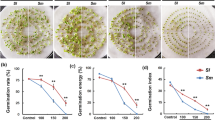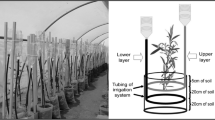Abstract
Salt spray is one of many abiotic factors that can influence plant productivity and species composition in coastal ecosystems. However, little is known about how marsh plants respond physiologically to the accumulation of sea aerosols on foliar tissues. In this study, experimental microcosms maintained in controlled greenhouse conditions were used to evaluate how low- (1.7 mg dm−2 day−1, weekly averages) and high- (8.6 mg dm−2 day−1) salt-spray loads would influence plant–water relations in Spartina alterniflora (Loisel.). While no differences in plant performance (e.g., changes in biomass and leaf area) were observed between the treatments and control plants, a number of physiological modifications attributed to salt spray were observed. In general, salt-treated plants underwent significant decreases in water potential (Ψ) and osmotic potential (Ψ π) and increases in leaf conductance (g) and bulk modulus of elasticity (ε). It is likely that these physiological responses were used to generate lower Ψ while maintaining osmotic and water homeostasis. That is, by decreasing Ψ π and increasing g and ε, more efficient water flow through the soil–plant–atmosphere continuum can be achieved, thus generating lower Ψ without promoting loss of turgor.





Similar content being viewed by others
Abbreviations
- g :
-
Leaf conductance
- P–V:
-
Pressure–volume
- P :
-
Turgor pressure
- W d :
-
Dry weight
- W f :
-
Fresh weight
- W t :
-
Turgid weight
- ε :
-
Bulk modulus of elasticity
- θ :
-
Relative water content
- θ sym :
-
Symplastic water content
- Ψ :
-
Water potential
- Ψ leaf :
-
Leaf water potential
- Ψ xylem :
-
Xylem water potential
- Ψ p :
-
Turgor potential
- Ψ π :
-
Osmotic potential
- Ψ satπ :
-
Osmotic potential at full saturation
- Ψ tlpπ :
-
Osmotic potential at turgor loss point
References
Adams, D.A. 1963. Factors influencing vascular plant zonation in North Carolina salt marshes. Ecology 44:445–456. doi:10.2307/1932523.
Ahmad, I. and S.J. Wainwright. 1976. Ecotype differences in leaf surface properties of Agrostis stolonifera from salt marsh, spray zone and inland habitats. New Phytologist 76:361–366. doi:10.1111/j.1469-8137.1976.tb01471.x.
Barbour, M.G. 1978. Salt spray as a microenvironmental factor in the distribution of beach plants at Point Reyes, California. Oecologia 32:213–224. doi:10.1007/BF00366073.
Barr, H.D. and P.E. Weatherley. 1962. A re-examination of the relative turgidity technique of estimating water deficit in leaves. Australian Journal of Biological Sciences 15:413–428.
Bolaños, J.A. and D.J. Longstreth. 1984. Salinity effects on water potential components and bulk elastic modulus of Alternanthera philoxeroides (Mart.) Griseb. Plant Physiology 75:281–284. doi:10.1104/pp.75.2.281.
Boyce, S.G. 1954. The salt spray community. Ecological Monographs 24:29–67. doi:10.2307/1943510.
Bradley, P.M. and J.T. Morris. 1991. The influence of salinity on the kinetics of NH+ uptake in Spartina alternijora. Oecologia 85:375–380. doi:10.1007/BF00320613.
Chen, Z., B. Li, Y. Zhong, and J. Chen. 2004. Local competitive effects of introduced Spartina alterniflora on Scirpus mariqueter at Dongtan of Chongming Island, the Yangtze River estuary and their potential ecological consequences. Hydrobiologia 528:99–106. doi:10.1007/s10750-004-1888-9.
Cheplick, G.P. and H. Demetri. 1999. Impact of saltwater spray and sand deposition on the coastal annual Triplasis purpurea (Poaceae). American Journal of Botany 86:703–710. doi:10.2307/2656580.
Flowers, T.J. and T.D. Colmer. 2008. Salinity tolerance in halophytes. New Phytologist 179:945–963. doi:10.1111/j.1469-8137.2008.02531.x.
Griffiths, M.E. 2006. Salt spray and edaphic factors maintain dwarf stature and community composition in coastal sandplain heathlands. Plant Ecology 186:69–86. doi:10.1007/s11258-006-9113-8.
Griffiths, M.E. and C.M. Orians. 2003. Responses of common and successional heathland species to manipulated salt spray and water availability. American Journal of Botany 90:1720–1728. doi:10.3732/ajb.90.12.1720.
Hester, M.W., I.A. Mendelssohn, and K.L. McKee. 2001. Species and population variation to salinity stress in Panicum hemitomon, Spartina patens, and Spartina alterniflora: morphological and physiological constraints. Environmental and Experimental Botany 46:277–297. doi:10.1016/S0098-8472(01)00100-9.
Hwang, Y.-H. and J.T. Morris. 1994. Whole-plant gas exchange responses of Spartina alterniflora (Poaceae) to a range of constant and transient salinities. American Journal of Botany 81:659–665. doi:10.2307/2445644.
Joly, R.J. 1985. Techniques for determining seedling water status and their effectiveness in assessing stress. In Evaluating seedling quality: principles, procedures, and predictive abilities of major tests, ed. M.L. Duryea, 17–28. Corvallis: Forest Research Laboratory, Oregon State University Press.
Koide, R.T., R.H. Robichaux, S.R. Morse, and C.M. Smith. 1989. Plant water status, hydraulic resistance and capacitance. In Plant physiological ecology: field methods and instrumentation, ed. R.W. Pearcy, J. Ehleringer, H.A. Mooney, and P.W. Rundel, 161–178. New York: Chapman and Hall.
Kramer, P.J. 1983. Water relations of plants. New York: Academic.
Longstreth, D.J. and B.R. Strain. 1977. Effects of salinity and illumination on photosynthesis and water balance of Spartina alterniflora Loisel. Oecologia 31:191–199. doi:10.1007/BF00346920.
Meinzer, F.C., M.J. Clearwater, and G. Goldstein. 2001. Water transport in trees: current perspectives, new insights and some controversies. Environmental and Experimental Botany 45:239–262. doi:10.1016/S0098-8472(01)00074-0.
Mooring, M.T., A.W. Cooper, and E.D. Seneca. 1971. Seed germination response and evidence for height ecophenes in Spartina alterniflora from North Carolina. American Journal of Botany 58:48–55. doi:10.2307/2441305.
Murillo-Amador, B., H.G. Jones, C. Kaya, R.L. Aguilar, J.L. García-Hernández, E. Troyo-Diéguez, N.Y. Ávila-Serrano, and E. Rueda-Puente. 2006. Effects of foliar application of calcium nitrate on growth and physiological attributes of cowpea (Vigna unguiculata L. Walp.) grown under salt stress. Environmental and Experimental Botany 58:188–196. doi:10.1016/j.envexpbot.2005.08.003.
Nabil, M. and A. Coudret. 1993. Effects of sodium chloride on growth, tissue elasticity and solute adjustment in two Acacia nilotica subspecies. Physiologia Plantarum 93:217–224. doi:10.1111/j.1399-3054.1995.tb02220.x.
Oosyting, H.J. and W.D. Billings. 1942. Factors affecting vegitational zoanation on coastal dunes. Ecology 23:131–142. doi:10.2307/1931081.
Pardossi, A., F. Malorgio, D. Oriolo, R. Gucci, G. Serra, and F. Tognoni. 1998. Water relations and osmotic adjustments in Apium graveolens during long-term NaCl stress and subsequent relief. Physiologia Plantarum 102:369–376. doi:10.1034/j.1399-3054.1998.1020305.x.
Pearcy, R.W. and S.L. Ustin. 1984. Effects of salinity on growth and photosynthesis of three California tidal marsh species. Oecologia 62:68–73. doi:10.1007/BF00377375.
Pezeshki, S.R. and R.D. DeLaune. 1993. Effects of soil hypoxia and salinity on gas exchange and growth of Spartina patens. Marine Ecology Progress Series 96:75–81. doi:10.3354/meps096075.
Phleger, C.F. 1971. Effect of salinity on the growth of a salt marsh grass. Ecology 52:908–911. doi:10.2307/1936042.
Romero-Aranda, R. and J.P. Syvertsen. 1996. The influence of foliar-applied urea nitrogen and saline solutions on net gas exchange of citrus leaves. Journal of the American Society of Horticultural Science 121:501–506.
Rozema, J., Y. Van Manen, H.F. Vugts, and A. Leusink. 1983. Airborne and soilborne salinity and the distribution of coastal and inland water species of the genus Elytrigia. Acta Botanica Neerlandica 32:447–456.
Rozema, J., P. Bijwaard, G. Prast, and R. Broekman. 1985. Ecophysiological adaptations of coastal halophytes from foredunes and salt marshes. Vegetatio 62:499–521. doi:10.1007/BF00044777.
Sánchez-Blanco, M.J., P. Rodríguez, E. Olmos, M.A. Morales, and A. Torrecillas. 2004. Plant and Environmental Interactions: Differences in the effects of simulated sea aerosol on water relations, salt content, and leaf ultrastructure on rock-rose plants. Journal of Environmental Quality 33:1369–1375.
Smart, R.M. and J.W. Barko. 1980. Nitrogen nutrition and salinity tolerance of Distichlis spicata and Spartina alterniflora. Ecology 61:630–638. doi:10.2307/1937429.
Stribling, J.M. and J.C. Cornwell. 2001. Nitrogen, phosphorus, and sulfur dynamics in a low salinity marsh system dominated by Spartina alterniflora. Wetlands 21:629–638. doi:10.1672/0277-5212(2001)021[0629:NPASDI]2.0.CO;2.
Sykes, M.T. and J.B. Wilson. 1988. An experimental investigation into the response of some New Zealand sand dune species to salt spray. Annals of Botany 62:159–166.
Touchette, B.W. 2006. Salt tolerance in a Juncus roemerianus brackish marsh: Spatial variations in plant water relations. Journal of Experimental Marine Biology and Ecology 337:1–12. doi:10.1016/j.jembe.2006.05.011.
Touchette, B.W. 2007. Seagrass-salinity interactions: physiological mechanisms used by submersed marine angiosperms for a life at sea. Journal of Experimental Marine Biology and Ecology 350:194–215. doi:10.1016/j.jembe.2007.05.037.
Touchette, B.W., L.R. Iannacone, G.E. Turner, and A.R. Frank. 2007. Drought tolerance versus drought avoidance: a comparison of plant-water relations in herbaceous wetland plants subjected to water withdrawal and repletion. Wetlands 27:656–667. doi:10.1672/0277-5212(2007)27[656:DTVDAA]2.0.CO;2.
Tyree, M.T. and H.T. Hammel. 1972. The measurements of the turgor pressure and the water relations of plants by the pressure-bomb technique. Journal of Experimental Botany 23:267–282. doi:10.1093/jxb/23.1.267.
Vasquez, E.A., E.P. Glenn, G.R. Guntenspergen, J.J. Brown, and S.G. Nelson. 2006. Salt tolerance and osmotic adjustment of Spartina alterniflora (Poaceae) and the invasive M halotype of Phragmites australis (Poaceae) along a salinity gradient. American Journal of Botany 93:1784–1790. doi:10.3732/ajb.93.12.1784.
Wilson, J.B. and M.T. Sykes. 1999. Is zoanation on coastal sand dunes determined primarily by sand burial or by salt spray? A test in New Zealand dunes. Ecology Letters 2:233–236. doi:10.1046/j.1461-0248.1999.00084.x.
Zhu, J.-K. 2001. Plant salt tolerance. Trends in Plant Science 6:66–71. doi:10.1016/S1360-1385(00)01838-0.
Acknowledgments
This study was supported by the North Carolina Sea Grant and the Elon University Center for Environmental Studies. We are grateful to S. Russell (Elon University) for providing laboratory assistance and J. Coker (Elon University) for kindly providing the materials.
Author information
Authors and Affiliations
Corresponding author
Rights and permissions
About this article
Cite this article
Touchette, B.W., Rhodes, K.L., Smith, G.A. et al. Salt Spray Induces Osmotic Adjustment and Tissue Rigidity in Smooth Cordgrass, Spartina alterniflora (Loisel.). Estuaries and Coasts 32, 917–925 (2009). https://doi.org/10.1007/s12237-009-9178-4
Received:
Revised:
Accepted:
Published:
Issue Date:
DOI: https://doi.org/10.1007/s12237-009-9178-4




